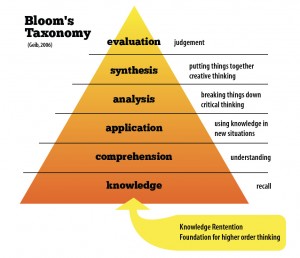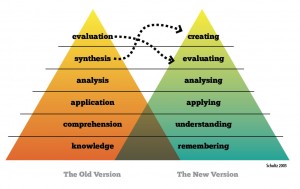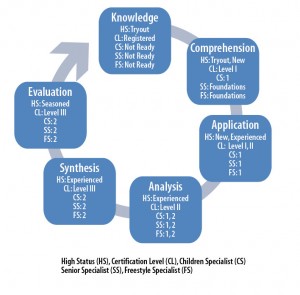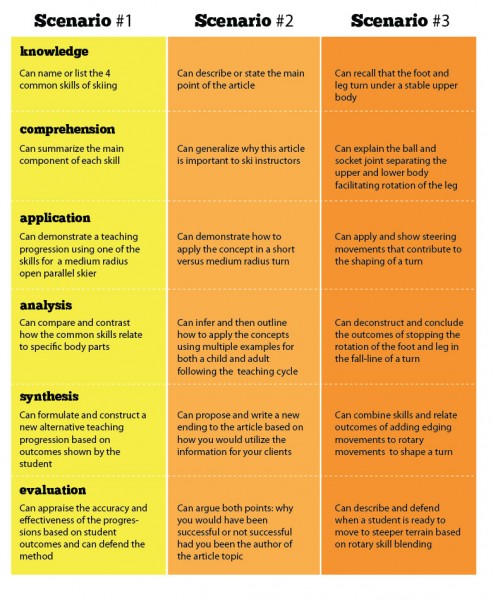By Kim Petram
If you search the Core Concepts Manual, 2001 you will find a brief discussion regarding the levels of understanding of how a student remembers information, broken down into the language of Benjamin Bloom. Ring a bell? Likely, like me, you have skipped over this topic in the past thinking that it’s good information but not applicable or readily usable to real skiing and riding or teaching situations.
I’ve recently been exposed to a deeper level exploration of the theories of Benjamin Bloom with my work on a team developing a national children’s education standard. I’m intrigued and feel that his model can be more widely used to assist in developing a matrix to determine how and when an instructor has attained learning. This is useful in many applications from training the new instructor to certification training: a format to help determine how you know when the student has mastered new information. This can be viewed as a tool to check for understanding.
Introduction
Benjamin Bloom (1913-1999) was a researcher in the field of education, professor in the Department of Education at the University of Chicago. His research helped, among many things, to lead to the establishment of the Head Start Program as well as the most commonly used concepts of determining learning in the educational system. Bloom, along with his partners, worked towards a development of specifications through which educational objectives could be organized according to their cognitive complexity.
What resulted from his work is Taxonomy of Educational Objectives: Handbook 1, the Cognitive Domain (Bloom et al., 1956, Eisner, 2000). At the University of Chicago, Bloom led his team of researchers in developing criteria to use in understanding learning domains in educational activities: cognitive (knowledge) affective (attitudes) and psychomotor (physical skills) identifications were the resultant work. This taxonomy, or classification, can be used together to understand and measure how critical thinking skills develop in a student. Hopefully, this noted CAP acronym is recognizable to the membership already, however the cognitive portion of the taxonomy can be more fully exposed to show how learning takes place by levels of achievement. The cognitive, or mental skills, classification regards levels of intellectual behaviors in learning and is the focus for this article.

Explanation
This hierarchical model, or taxonomy, is a tiered system of classifying thinking skills according to six cognitive levels of complexity: Knowledge, Comprehension, Application, Analysis, Synthesis and Evaluation
- Knowledge or the recall of data and information, expresses the natural urge to recall previously learned material.
- Comprehension is the ability to grasp meaning, explain, restate ideas, understanding the basic information and be able to understand, interpret or extrapolate it.
- Application is the ability to use learned material in new situations or the unprompted use of an abstraction; involves using information, ideas, and skills to solve problems, then selecting and applying them appropriately.
- Analysis involves separating information, or separate material, into component parts and showing the relationships between parts. This includes breaking apart information and ideas and the ability to distinguish between fact and inference.
- Synthesis suggests the ability to put together separate ideas to form new wholes of a fabric, or establish new relationships: putting together ideas and knowledge in a new and unique form. Can build a structure or pattern from diverse elements, potentially creating new meanings.
- Evaluation is the ability to judge the value or worth of material and ideas against stated criteria. This involves reviewing and asserting evidence, facts, and ideas, then making appropriate statements and judgments.
(Clark, 2009/Tormod, 2009)
What is taxonomic about the taxonomy is that each subsequent level depends upon the student’s ability to perform at the level or levels that precede it. For example, the ability to evaluate—the highest level in the cognitive taxonomy—is predicated on the assumption that for the student to be able to evaluate, he or she would need to have the necessary information, understand the information he or she had, be able to apply it, be able to analyze it, synthesize it and then eventually evaluate it. The taxonomy is no mere classification scheme. It is an effort to hierarchically order cognitive processes.
(Eisner, 2000)
Bloom recognized that what was important in education was not that students should be compared, but that they should be helped to achieve the goals of the curriculum they were studying. Goal attainment rather than student comparison was important. The process of teaching needed to be geared towards the design of tasks that would progressively and ineluctably lead to the realization of the objectives that defined the goals of the curriculum. The variable that needed to be addressed, as Bloom saw it, was time. It made no pedagogical sense to expect all students to take the same amount of time to achieve the same objectives. (Eisner, 2000)
Using this concept as a curriculum tool for snowsports trainers is meaningful in creating individual learning plans for staff as well as in guiding participants through the certification processes and member offerings. Meeting the set standards of any snowsport educational goal can be accomplished individually based on each student’s movement through the taxonomy.
Exploring Further
Below is a graphic showing the taxonomy with corresponding descriptors that more succinctly explains the level of function at each cognitive process. This is another way to describe examples of how a student would show comprehension and learning within each level.

As you can see, the levels build upon themselves. Again, a student cannot successfully master the next level until the previous level is fully comprehended. Used as a tool, higher level thinking skills will be allowed to develop in a systematic process. A snowsport evaluator or trainer will be able to judge or determine levels of skill by assessing at what level a student is currently functioning at, and, hopefully, will remain at the student’s current level until mastery is obtained before introducing or expecting higher functioning processes.
As it often seems, nothing stays the same and an updated version of the taxonomy was introduced to add relevancy to current educational practices (see Figure 2). Noted below is a different compilation identifying the six levels of the cognitive domain. These levels are based on the same levels of cognition from Bloom’s Taxonomy, but reflect the revised version completed in 2001. The original language is noted in parenthesis. A former student of Bloom’s, Lorin Anderson, along with her cohorts, revisited the cognitive domain of the taxonomy and made revisions that reflected an updated and more current language: nouns instead of verbs for labeling and a rearrangement, renaming and restructuring of the higher levels. (Forehand, 2005) Key verbs have been added to assist in developing an understanding of how the student could indicate their successful mastery of knowledge at each level. Utilization of either taxonomy for current applications is fine. The literature search demonstrates that often a blending of the original and new models exist and are incorporated into training programs.
Remember (Knowledge Level)
Recall or recognize terms, definitions, facts, ideas, materials, patterns, sequences, methods, principles. Key Verbs: name, list, state, describe, recall, label, retrieve, recognize.
Understand (Comprehension Level)
Read and understand descriptions, communications, reports, tables, diagrams, directions, regulations. Key Verbs: paraphrase, identify, explain, translate, interpret, interpretation, classify.
Apply (Application Level)
Know when and how to use ideas, procedures, methods, formulas, principles, theories.
Key Verbs: execute, compute, demonstrate, modify, discover, predict, show, solve, implement.
Analyze (Analysis Level)
Break down information into its constituent parts and recognize their relationship to one another and how they are organized; identify sublevel factors or salient data from a complex scenario.
Key Verbs: diagram, , illustrate, outline, infer, conclude, differentiate, attribute, compares, contrasts.
Create (Synthesis Level)
Put parts or elements together in such a way as to reveal a pattern or structure not clearly there before; identify which data or information from a complex set is appropriate to examine further or from which supported conclusions can be drawn. Key Verbs: create, compose, design, reorganize, formulate, write a new ending, tell.
Evaluate (Evaluation Level)
Make judgments about the value of proposed ideas, solutions, etc., by comparing the proposal to specific criteria or standards. Key Verbs: judge, appraise, compare, contrast, criticize, justify, critique. (Schultz, 2005, Clark, 2009)
This taxonomy could be applied to a snowsport instructor (see Figure 3). Included are various educational endeavors an instructor may pursue in the PSIA-NW Division and the likely corresponding category the instructor would be placed given the standard of each program.

The Practicum
So let’s take the information described thus far and apply it to snowsport scenarios. I’ve listed three different scenarios but a coach or TD or anyone imparting knowledge to another should be able to incorporate their own matrix to evaluate the acquisition and use of knowledge.
Scenario 1:
Instructor John is working towards Level II certification. He has three years of ski instruction under his belt. John is a part-time instructor, working on weekends for his snowsports school. John is asked to explore his knowledge of the skiing skills concept.
Scenario 2:
You have received your PSIA/AASI-NW Snowsports Instructor magazine, Spring 2010. You have read the article, First the Proof, Then the Pudding by Dave Lucas. You are explaining this article to your fellow instructor friend.
Scenario 3:
Exploration of the transition from certification level I to certification level II utilizing the fundamental skill concept of rotary. (See Figure 4).

Summary
In researching this article it became very clear that there are hundreds of applications in various forms utilizing Bloom’s Taxonomy. There is supportive data indicating how the implementation of the taxonomy can insure the alignment of objectives with standards and assessments. Bloom’s Taxonomy has been closely linked with the study of multiple intelligences. (Forehand, 2005) These potential applications alone are linked directly with the standards and core concepts of the snowsports instructor
Bloom’s Taxonomy can be used to facilitate an awareness of how to measure higher level thinking skills. As instructors, we are having to constantly evaluate how well our student is progressing to determine when it is time to move on or when reinforcement is required. Whether it is a fellow instructor preparing for an exam, a student wanting to explore more of the mountain environment, a participant in a specialist program trying to master the theory content or yourself determining if you are ready for your next level of adventure, utilizing the taxonomy is an efficient and proven method to determine proficiencies.
Applied to snowsports instructors, whether one is evaluating skiing or riding skills, technical information or teaching competencies Benjamin Bloom has created a classification system to help anyone move beyond the basic ability to recall information and know that they have successfully moved to complex cognitive functioning by utilizing real and consistent measurements. Applied to our industry, the classification system can create a pathway for consistent standardization of programs and goals. Establishing standards of knowledge for yourself and your snowsports school is the path towards meeting the mission of PSIA/AASI: to help teachers of all snowsports to effectively share their passion for the sport they love.
References
Bloom, Benjamin S., e. (1956) Taxonomy of Educational Objectives: The Classification of Educational Goals. By a committee of college and university examiners. Handbook 1: Cognitive Domain, New York, David McKay Co Inc.
Bloom, Benjamin: All Our Children Learning. McGraw-Hill. New York, 1981
Sources
Eisner, Elliot W. Lee Jacks Professor of Education and Professor of Art, Stanford University.
Tormod Kinnes, 2002–2009.
Schultz, Lynn 2005.
http://www.odu.edu/educ/roverbau/Bloom/blooms_taxonomy.htm
Forehand, M. 2005. Bloom’s Taxonomy: Original and revised.
Geib, Richard. www.geibtechforlearning.org/apu/edu-522/
Clark, Don. Big Dog and Little Dog’s Performance Juxtaposition. Updated May, 26, 2009.
[connections_list id=37 template_name=”div_staff”]
2 thoughts on “Bloom’s Taxonomy: Levels of Understanding”
I would love to be able to just print these articles with the touch of a button. This is a great one to share.
Thanks, Ellen
This article appeared in the the Summer 2010 issue of the NW Snowsports Instructor, which you can download from this website here: http://www.psia-nw.org/newsletter/back-issues/ or you can download the PDF with this link: http://www.psia-nw.org/wp-content/uploads/2009-10_Summer.pdf. Another great way to share this article is to simply direct people to this page (the page you are on): http://www.psia-nw.org/newsletter-articles/blooms-taxonomy-levels-of-understanding/. You may also now simply click the little printer icon appearing at the bottom of the main content area of pages which links to an external free service for printing just the post content. Or better yet, simply share this page with your friends via Facebook, Twitter or other social media outlet. Thanks for the idea Ellen!